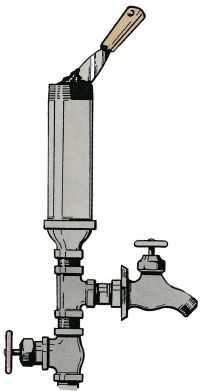How To Stop Water Hammer
Water hammer is a specific plumbing noise, not a generic name for pipe clatter. It occurs when you shut off the water suddenly and the fast-moving water rushing through the pipe is brought to a quick halt, creating a sort of shock wave and a hammering noise. Plumbing that's properly installed has air chambers, or cushions, that compress when the shock wave hits, softening the blow and preventing this hammering. The chambers can fail, though, because water under pressure gradually absorbs the air.
If you never had hammering and then it suddenly starts, most likely your plumbing system's air chambers have become waterlogged. You can cure water hammer by turning off the water behind the waterlogged chamber, opening the offending faucet and permitting the faucet to drain thoroughly. Once all the water drains from the chamber, air will fill it again and restore the cushion. If the air chamber is located below the outlet, you may have to drain the main supply lines to allow the chamber to fill with air again.
Advertisement
The air chamber will not drain properly if it's clogged with scale or residue from chemicals or minerals in the water. The chamber always should be larger than the supply pipe to preclude such clogging. Since the chamber is simply a capped length of pipe, however, all you have to do to clear it is remove the cap and clean out the residue.
What do you do if there are no air chambers built into your plumbing system? You must do something, because water hammer pressures may eventually cause damage: failure of fittings or burst pipes, for example. Because water hammer is most often caused by water pressure that's too high, the first step is to reduce the water pressure if possible. Sometimes this isn't feasible because a reduction in pressure may result in only a dribble of water at an upper-floor faucet if one on the first floor is turned on.
Where the idea is a workable one, you can reduce pressure by installing a pressure-reducing valve in the supply line that comes into the house. The same purpose is served by installing a globe valve at the head of the affected pipeline. But this too may result in pressure too low for proper operation when other faucets are open.
If pressure reduction is not feasible or is ineffective, install the necessary air chambers to prevent water hammer. If you have no room to make the installation without tearing into a wall, go to a plumbing supply dealer and find out about the substitute devices designed for such problem areas. Many of these devices have a valve that makes it easy for air to re-enter the system.
The next time you hear noises or clatter coming from your home's plumbing system, try the solutions mentioned in this article. The same goes for leaking, sweating, or frozen pipes. If you can solve the problem right away, you can prevent it from becoming more serious.
Plumbing: Tackling plumbing problems in the home can be quite daunting. Don't dismay -- the plumbing tips detailed in this article are sure to help, even if helping means advice on when to call a plumber.
- How to Fix a Toilet: Yes, it's a job no one really wants to tackle. And no, you don't have to call a plumber for every toilet problem. Learn how to fix a toilet at HowStuffWorks.
- Plumbing Troubleshooting: Sometimes figuring out what's wrong with your toilet, drain, or other plumbing-related area is half the battle. Find helpful troubleshooting tips here.
- Plumbing Tools: You may already have many of the tools necessary for most plumbing jobs because they are the same tools used for other do-it-yourself projects. Find out about special plumbing tools, such as pipe wrenches, in this article.
